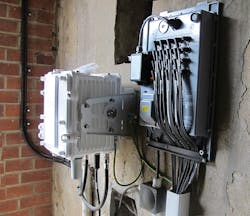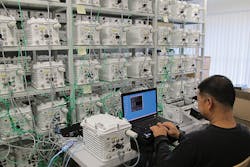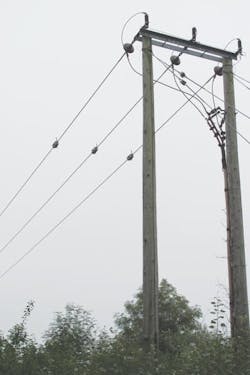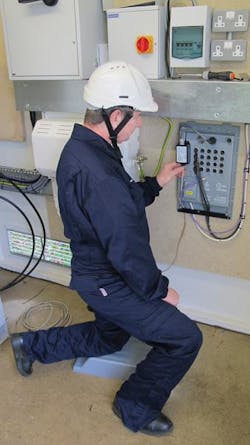The United Kingdom’s electricity and gas regulator Ofgem estimates the rate of investment on electricity networks will double in the next 10 years to 32 billion pounds, which is twice the level of investment during the past 20 years. The investment needs to be smarter, using a range of new innovative intervention techniques as an alternative to conventional distribution network reinforcement.
Through Ofgem’s Low Carbon Network Fund, designed to support projects sponsored by distribution network operators, the Flexible Approaches to Low Carbon Networks (FALCON) project aims to investigate how new 11-kV techniques can work in practice. Furthermore, as part of the project, a new tool will be built to allow the simulation of future network challenges expected to arise from an increase in low carbon technology and generation.
Designed to either defer or even eliminate the cost of reinforcing the 11-kV network, the project will trial several new intervention techniques as well as a commercial demand-side management scheme. A fundamental part of the project will be to share with other distribution network operators the process Western Power Distribution (WPD) follows to improve future investment decisions. WPD is working with partners such as Cisco and Alstom on this project, which is focused on the provision of networks to support future energy demands.
The FALCON Project
To address network constraints, FALCON has deployed four technical intervention techniques:
• Dynamic asset rating
• Automated load transfer
• Meshed networks
• Energy storage.
Based on the data received from these field trials, FALCON will develop a prototype scenario investment model that will include a network modeling tool to identify potential constraints. Furthermore, it will provide a decision-support system to help identify the most cost-effective network intervention to relieve capacity constraints. Finally, industry data will be used to assess the effectiveness of using industry-created load estimates as an alternative to real-time substation monitoring.
Communications Infrastructure
The FALCON project is being trialed in Milton Keynes, a relatively new town in central England, which has required the installation of a wide-scale telecommunications system throughout some 200 11-kV substations.
An important feature of the project was the design of this communications infrastructure in support of each of the intervention techniques. This was achieved by breaking each technique down into a set of functions, whereby this decomposition led to the identification of requirements, making it possible to map the communications requirements for each function. This ensures all the communications areas have been considered, highlighting any potential issues such as application protocol mismatches, bandwidth latency and security requirements.
Early on in the project, the team discovered simple line-of-sight restrictions (such as seasonal changes across wooded areas) could have an impact on the network. Subsequently, the team also has seen several other effects, including signal loss from new construction work taking place in the line of sight, trucks parking overnight in the line of sight of antennas and vegetation growth, which can have an attenuating effect, particularly when dampened by rain.
The communications infrastructure is a critical component of the FALCON project. It is designed to link the 200 secondary substations securely within the trial distribution network with the trials network manager and data storage. To secure communications with these secondary substations, an Internet protocol (IP) platform will be used with IEEE802.16e WiMAX technology, providing the physical connectivity. The traffic will be routed by the Cisco Connected Grid in each primary substation and the ruggedized field area routers installed in each secondary substation.
Therefore, the communications infrastructure effectively shadows the electricity distribution network with the secondary substations (connected through the WiMAX radio on 1.4 GHz) radiating out from the primary substations in a hub-and-spoke-type arrangement. Data from the monitoring devices and relays in each secondary substation will be connected to the router through a remote terminal unit (RTU) for analogs or directly through the Ethernet station bus. The trial area includes one control center, nine primary substations and 200 secondary distribution substations.
The communications network, based on a private network infrastructure, will transport both monitoring- and control-related traffic for the intervention techniques. The network is based on IPv4 and related technologies. Within the primary and secondary substations, an Ethernet-based station bus will be used.
The existing communications to the substations are based on an ultrahigh-frequency (UHF) radio network. As the new monitoring and control functions are deployed over the IP-enabled WiMAX communications network, it is anticipated one future communications scenario could be for all communications to migrate gradually from the UHF radio-based infrastructure.
Within the primary substations, a ruggedized router will be installed to provide wide area network (WAN) routing and firewalling. This will be connected to a WiMAX base station node to provide the backhaul on the 3.5-GHz frequency. A ruggedized Ethernet switch will provide the IEC 61850 station bus connecting the substation RTUs and intelligent electronic devices (IEDs). Multiple WiMax devices provide pico cell coverage from the primary substation to enable connectivity to the secondary substations.
In each secondary substation, a ruggedized field router with a 1.4-GHz WiMAX module will be used. This provides Ethernet connectivity within the substation and uses the WiMAX network to backhaul the traffic.
Dynamic Asset Rating
Static ratings on medium-voltage network assets allow wider design assumptions to be used across different network types, reducing the need for monitoring. However, if an asset is subject to real-time monitoring, a dynamic rating can be applied to take advantage of the cyclic nature of the load.
By controlling the use of this cyclic rating, the load capability of the network can be increased without adversely affecting the asset’s life span. To assign a dynamic asset rating, a communications infrastructure and remote monitoring are required along with the implementation of changes to network operational procedures. Dynamic ratings can be applied to transformers, underground cables and overhead lines across all voltages, but it is usually most cost-effective to monitor the load current on overhead lines because of the simplicity of installation.
The FALCON project has installed monitoring equipment on a mix of 33/11-kV transformers, 11-kV/433-V transformers, underground cables and overhead lines at 28 locations. This allows a dynamic asset rating to be assigned to these network assets, but it may require intervention in the normal running arrangements of the network around these locations.
Automatic Load Transfer
The 11-kV distribution network is comprised of radially fed networks, whereby two or more circuits from a primary substation feed through to normally open points at an 11-kV/low-voltage secondary substation. Each secondary substation is usually equipped with an 11-kV ring main unit that offers the potential for the substation to be supplied from either of the two circuits connecting it to the primary substation. The automatic load transfer facility takes advantage of this network design feature by remotely operating the 11-kV switchgear in secondary substations to transfer the supply automatically to an alternative circuit.
This automation facility allows load transfer between lightly and heavily loaded circuits. In the event, of an 11-kV fault, the length of the supply interruption can be reduced significantly. In addition to equipping 11-kV/low-voltage secondary substations with remotely operable automated switchgear and grading existing protection settings to the possible alternative network topologies, the visibility of the load current is required in the control center.
The FALCON project will trial three automated load transfer schemes on six existing 11-kV underground cable and overhead line circuits. Pole-mounted auto reclosers and automated section switches will be used on the overhead line circuits, and automated switchgear will be installed in the secondary substations supplied through underground cables.
The automatic load transfer technology will require a resilient and robust hybrid communications infrastructure at primary and secondary substations. Automation using general packet radio service (GPRS) communications will be required for the pole-mounted Schneider RL sectionalizers currently installed; additional pole-mounted sectionalizers equipped with a RTU also will be required. The role of communications is critical because control of these pole-mounted devices is a centralized function with no local automation.
A phasor measurement unit (PMU) also will be installed in each primary substation to monitor the feeders out to the trial network. PMUs can have a significant impact on the communications network, generating data streams of more than 100 kbps/feeder. The communications infrastructure is vital for both controlling the sectionalizer and ensuring the RTU and PMU data reaches the control center in a timely fashion so appropriate control action can be taken.
Meshed Networks
Secondary substations on meshed networks have two potential sources of supply and are operated on a permanently closed ring with protection zones designed to ensure the network continues to operate safely. The number of protection zones employed is dependent on cost and the need to minimize the number of customers suffering a loss of supply in the event of a fault on the closed ring network. To achieve this objective, the closed ring network must be designed with circuit breakers installed in strategic secondary substations.
The application of meshed networks is usually limited to city centers, where the distribution network is required to supply high-load-density development. The FALCON project will explore the benefits of meshed networks when applied to suburban and rural areas by trialing three meshed networks comprising six existing 11-kV feeders. This will require the existing overcurrent protection schemes to be upgraded to include directional overcurrent protection.
The directional overcurrent protection scheme will use IEC 61850 generic object-oriented substation events messages (GOOSE), which are two-layer, multicast messages. This protection scheme is less time critical than unit protection schemes, but there are stringent communications requirements in terms of latency and synchronicity. The interstation communications is through a WiMax network, which meets the maximum latency of 80 msec required by the project. The technology trialed has been designed to exceed those requirements, and the project team anticipates 40 msec can be achieved consistently, with a potential minimum of 20 msec.
Energy Storage
Energy storage involves installing one or more batteries on the network, charging these at times of low demand and discharging them at times of high demand. The effect is to reduce the network energy demand at peak times, thus accommodating additional power flows within the same available network capacity.
Batteries are installed in ground-mounted secondary substations on the low-voltage side of the 11-kV/low-voltage transformer. The charging/discharging regime is controlled by a set of algorithms that respond to network demand or by designing set time frames to cope with daily or seasonal peaks. The secondary substations require monitoring to be installed to drive the charging and discharging algorithms. Power conditioning units (PCUs) are typically installed with the battery arrays to optimize performance and provide communications.
Storage that can be installed virtually anywhere on the 11-kV network where there are space and support availability is highly effective in addressing constraints that only last for short periods of the day, for example, one or two hours at times of peak consumption. One of the advantages of the battery solution is the speed at which it can be deployed or redeployed
The FALCON project includes the installation of batteries in five 11-kV/low-voltage secondary substations. Each battery array will have a capacity of 10% to 20% of the installed 11-kV/low-voltage transformer capacity over a one- to two-hour period. These battery installations will include a PCU, communications and substation metering. A RTU also will be required at each site for measurement and data logging.
Future Functions
WPD has installed much of the engineering required for the intervention techniques. Alongside this, WPD is well into developing the new network planning tool, the scenario investment model. The scenario investment model will model the networks into the future, taking into account different seasonal peaks to allow the planners to pick the best tool from the toolbox when looking at developing the network.
Acknowledgement
The author acknowledges the help and support of Andrew Longyear of Cisco Systems in the preparation of this article.
Roger Hey has worked in the electricity industry for more than 20 years. Originally joining East Midlands Electricity, industry changes have led to positions in Powergen, E.ON and now Western Power Distribution. In 2008, Hey was asked to establish a Future Networks strategy and a team of specialist engineers. This team is responsible for the business’s innovation strategy, delivery of demonstration projects and implementation of new solutions into core business activities.
Mentioned in this article:
Alstom | www.alstom.com
Cisco | www.cisco.com
GridKey | www.gridkey.co.uk
Ofgem | www.ofgem.gov.uk
Schneider Electric Co. | www.schneider-electric.com
Western Power Distribution | www.westernpower.co.uk




